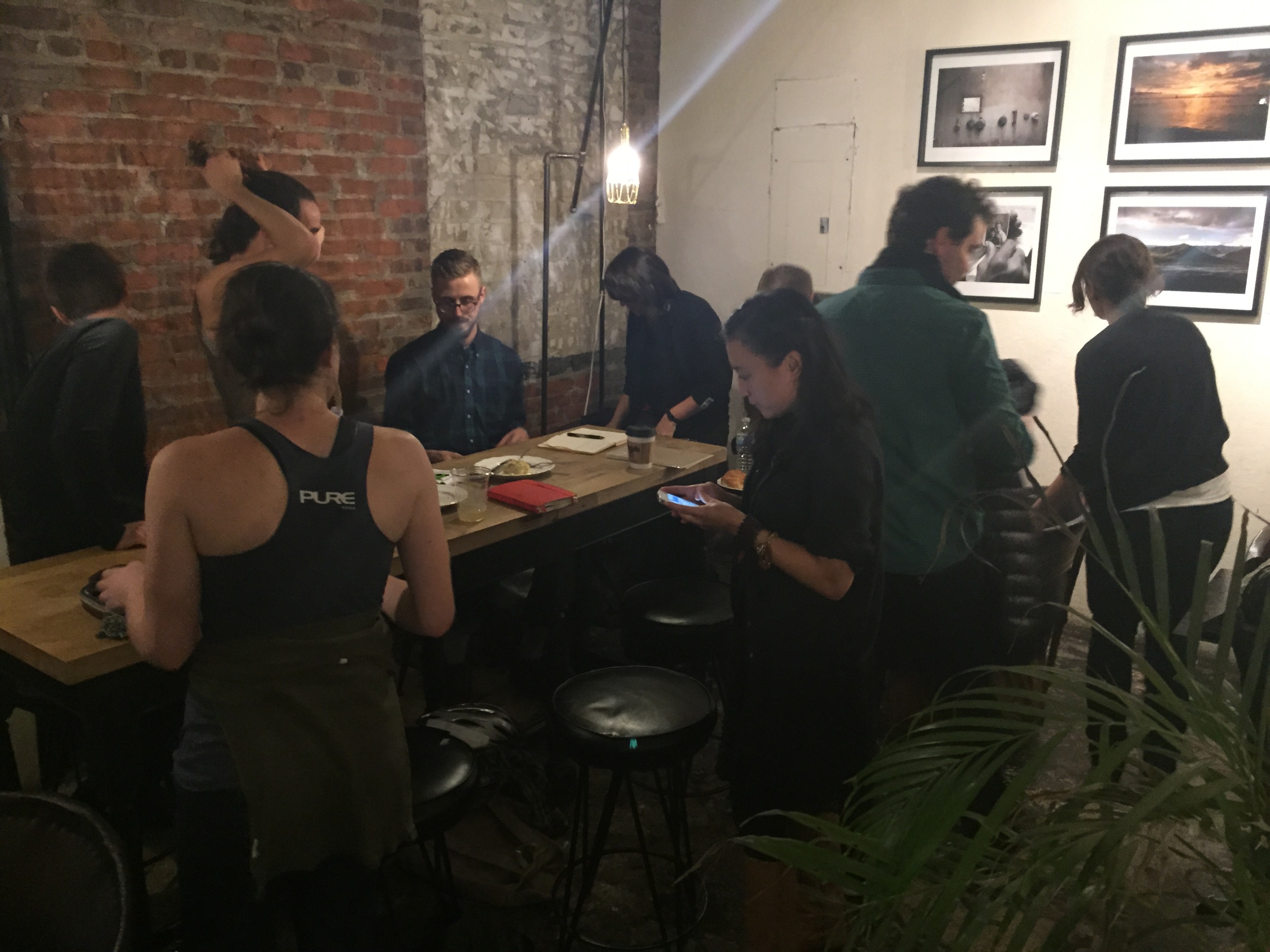Meaning
Through the process of creating content whether in material form or not, meaning can be conveyed on two levels. There is an implied meaning in the work and a stated meaning. The stated meaning or idea that a maker wants to communicate about something specific to their audience may not always be clear without background knowledge of the artist or the work. The implied meaning of the work is what influences an audience to understand that a certain point of view is being depicted or that the maker created the work intentionally. Implied meaning is the result of certain devices being used in a body of work repetitively and consciously. These devices and formal elements vary for different makers and their work.
DISCUSSION 6
February 24, 2015
Location: Crown Heights, Brooklyn
Host: Crystal Gregory
Contributors:
Crystal Gregory begins the final conversation of the meaning series by describing how each artist in the group appears to work in two modes. She describes how Jonathan Allen works between painting and performance, Lee Hunter works between sculpture and photography, Robin Kang between textile and print, Sarah Williams with sculpture and installation, and Seldon Yuan between poetry and visual art. Chrystal asks how these two modes of working influence each other and are related. Lee Hunter begins by saying that these modes are not very different at all. Jonathan Allen explains how the same idea can be conveyed in different materials. Everyone agrees that working through several modes helps to keep an engaging and active practice. Jonathan also talks about two different approaches to creating: one with a clear intention and creating based on a specific goal versus creating through experimentation and process. We describe the latter process as being much riskier and producing more failure but somehow more engaging. Seldon Yuan, on the other hand, explains that his practice is rooted in having a specific idea in mind and he rejects the idea of stopping when the work looks good enough. He discusses the concept of generosity and the necessity of artists being generous with their audiences by helping them access the work. He uses Gabriel Orozco’s Yogurt Caps as an example, citing that Orozco was not generous to his audience in the obscure gesture and how problematic it can be to make work that you yourself cannot connect to. Crystal poses the question importance of time and labor to a practice. She describes that her labor-intensive practice allows for more time to think through the materiality and the ideas in the work. We discuss the assistant-based studio practice which removes the artist from their own work and de-authenticates the work on some level. Seldon discusses the intimacy that’s created by spending more time by creating the work. However, de-skilling and skill-resistant practices have become applauded over craft-based practices. We go on to talk about the artist acting as an architect in drafting the blue print of the work but executing it less and less. Crystal references Jan Verwoert’s video “Why are conceptual artists painting again? Because they think it’s a good idea” from our third meaning discussion when she asks the group whether they believe in an architect-based studio practice where the building the house is the project or the housewife-based practice where the laboring overing the maintence of the house is the project.

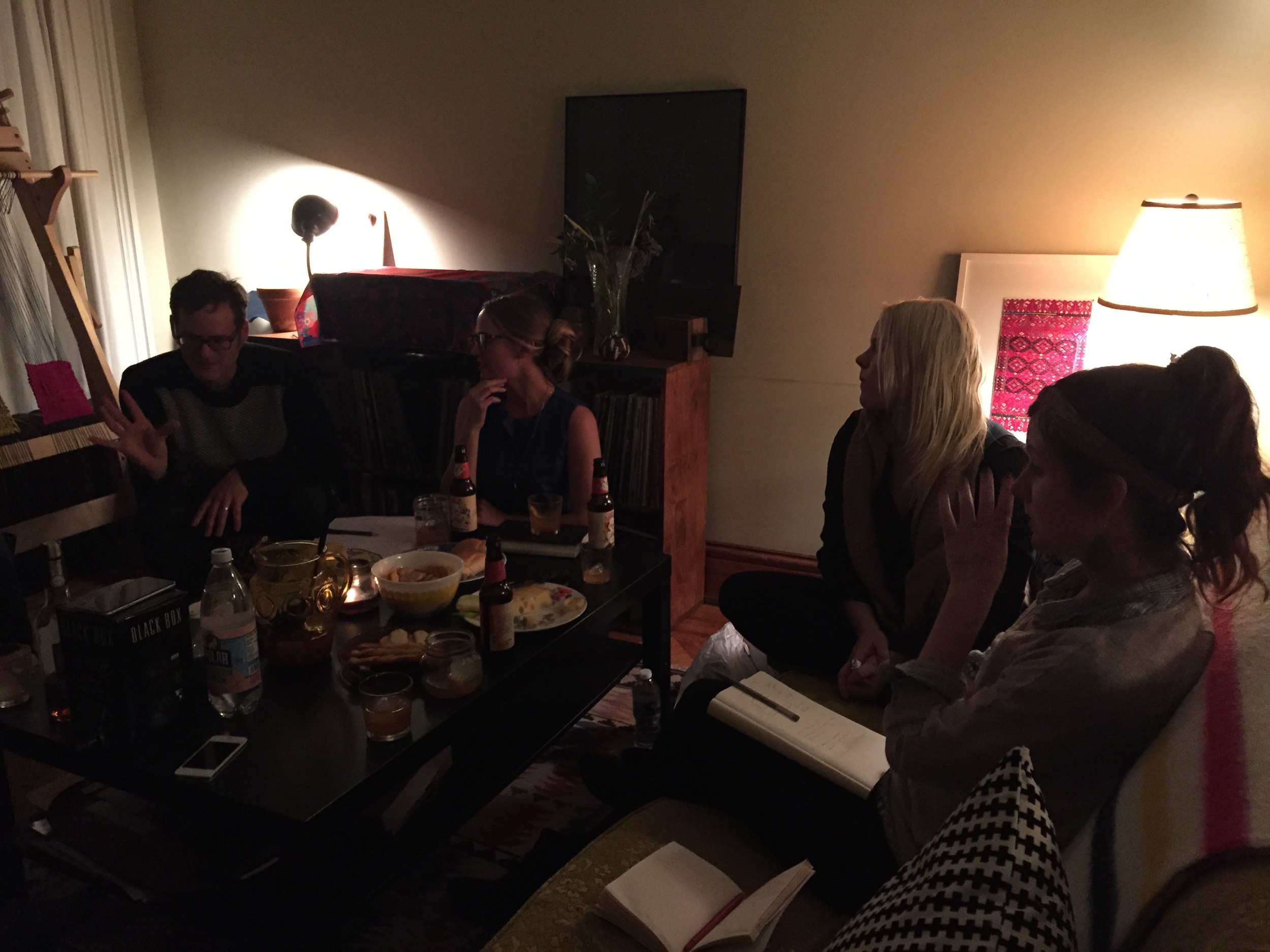
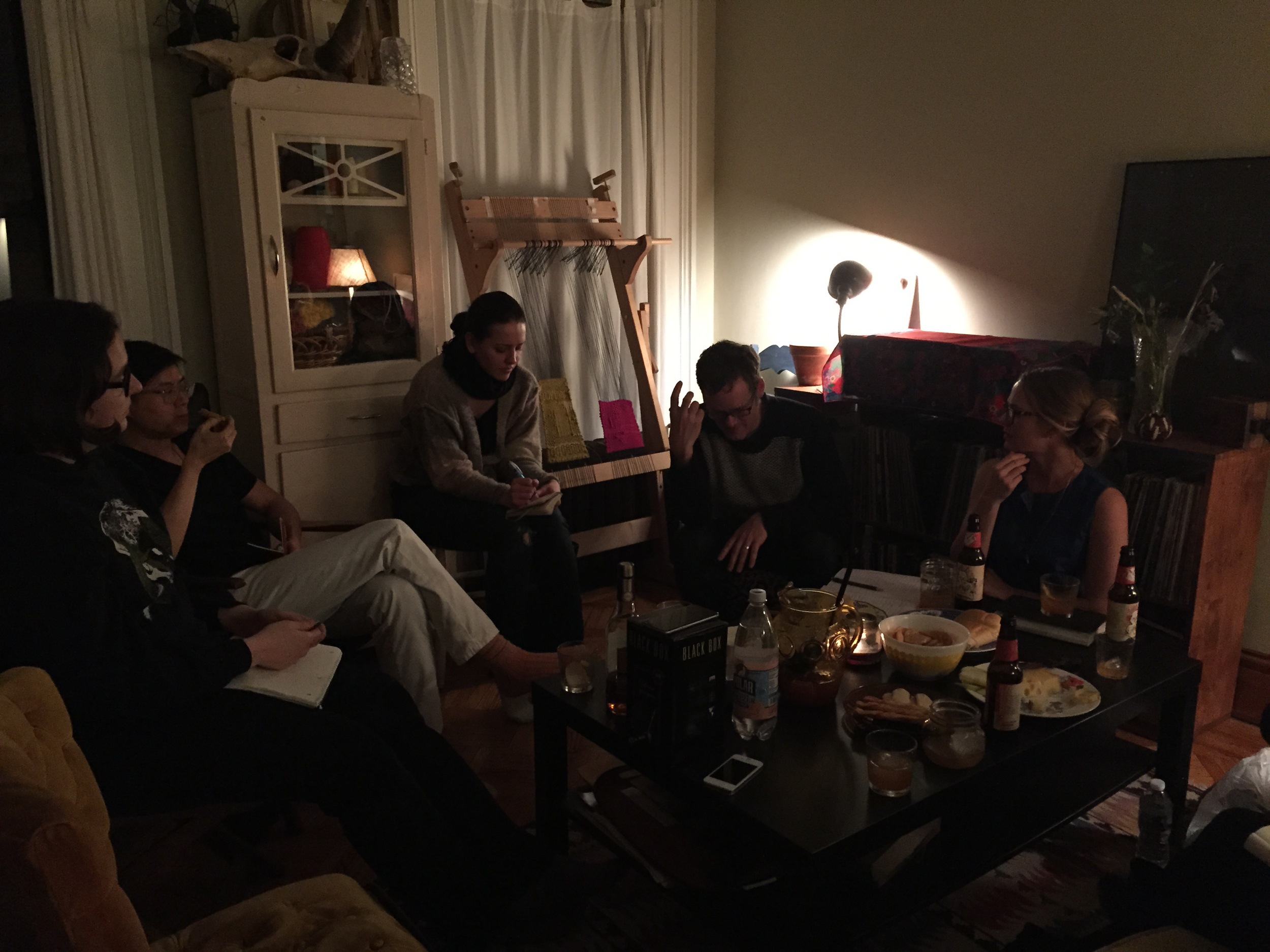
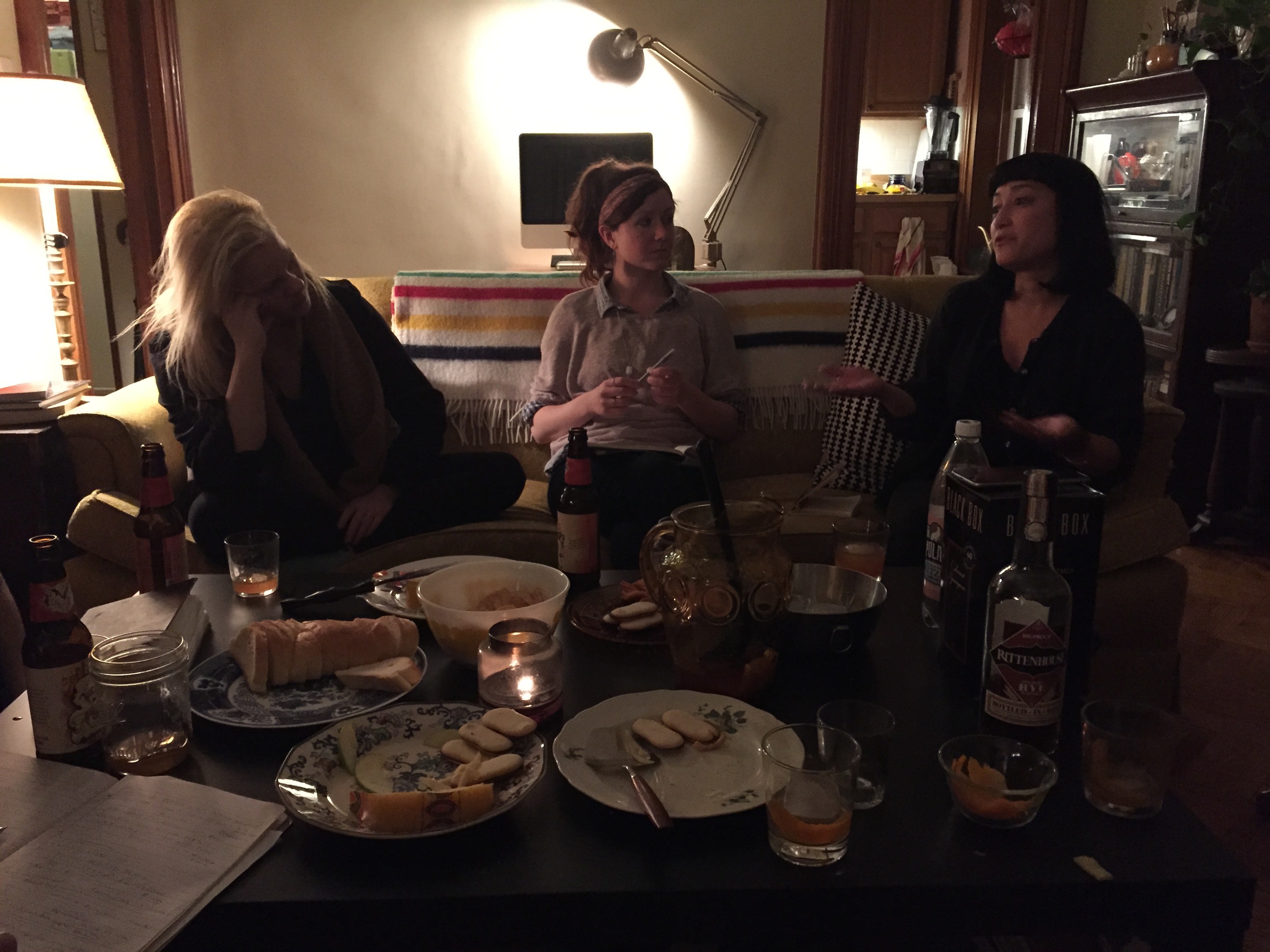

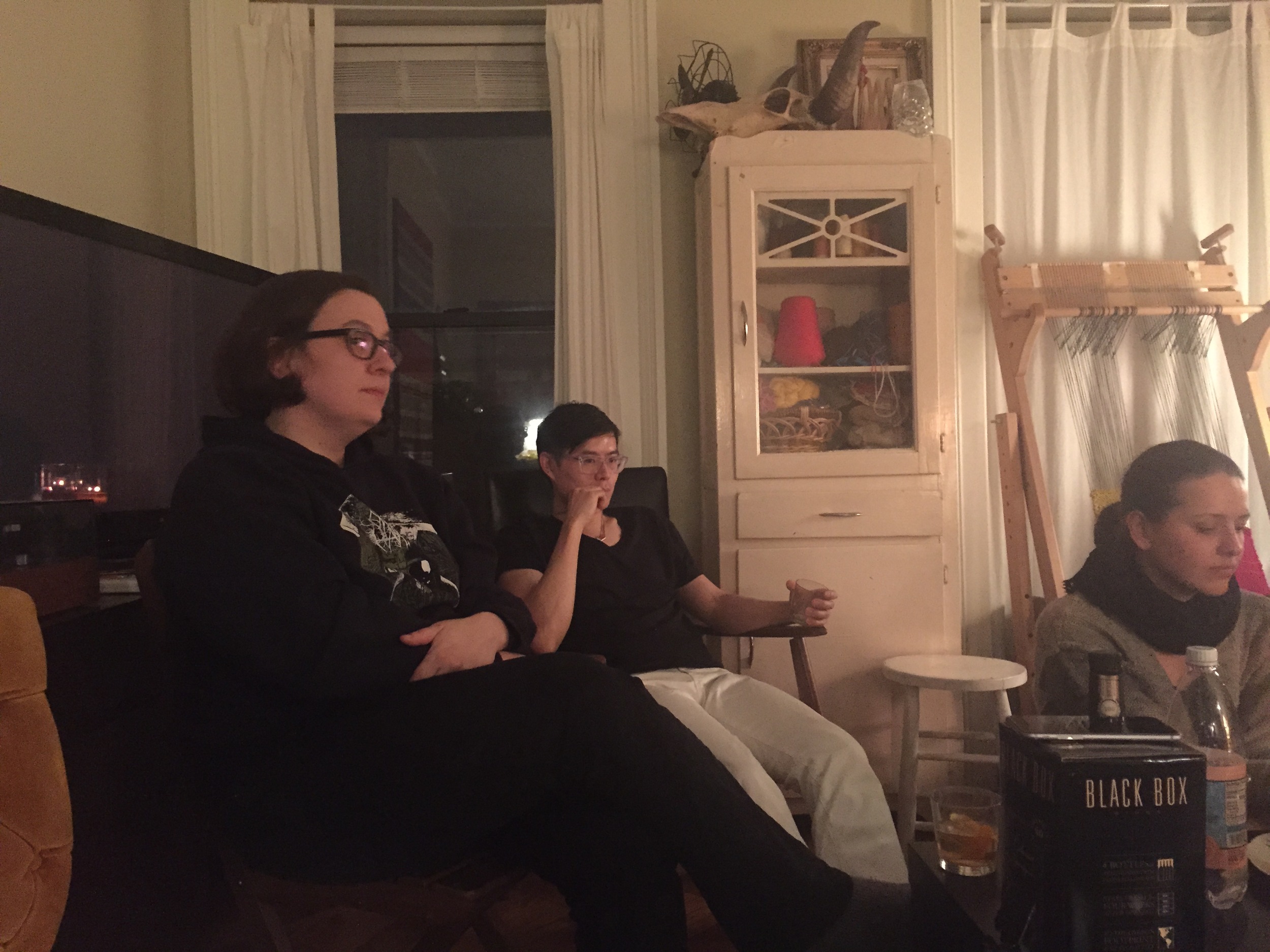

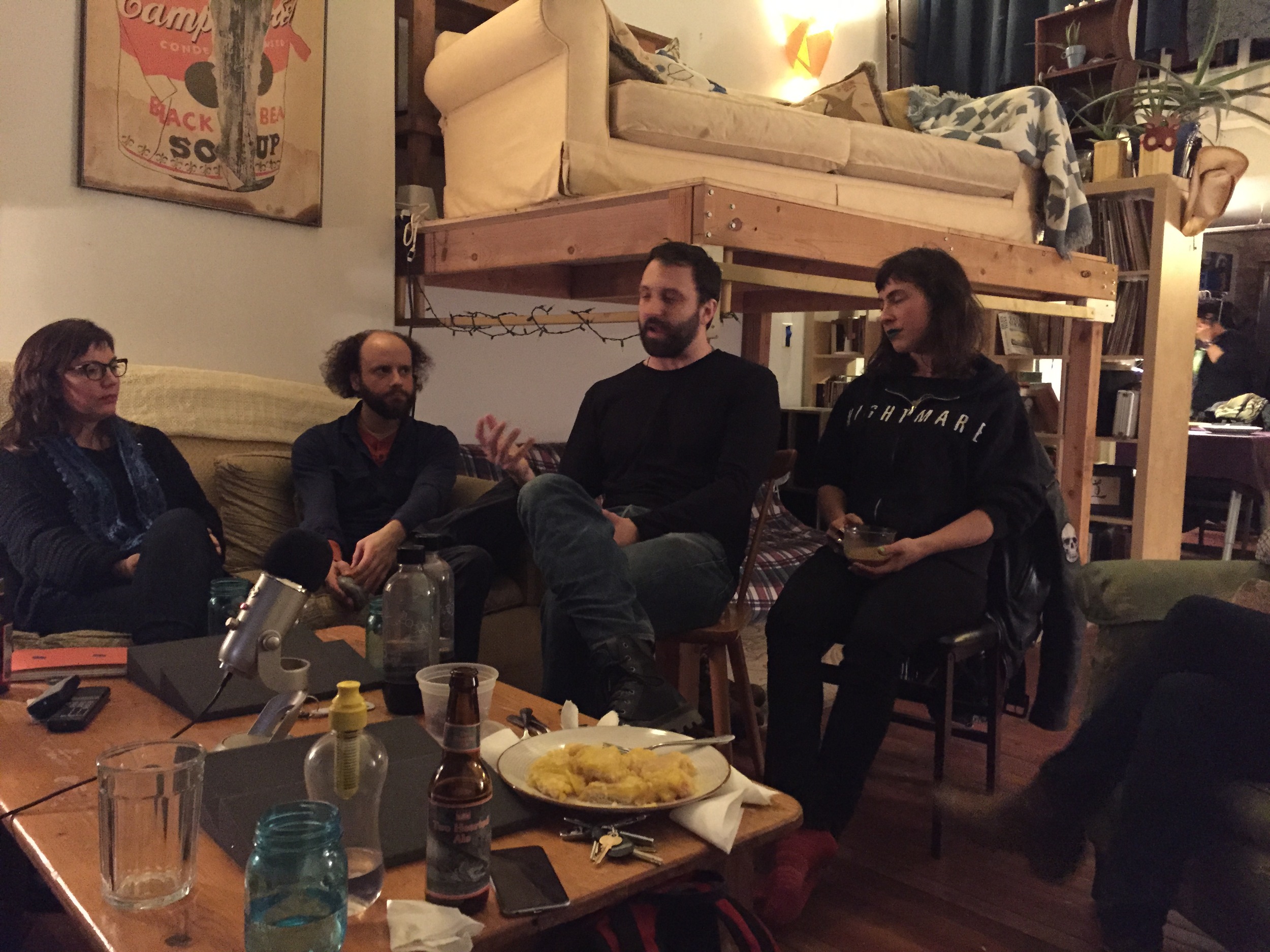
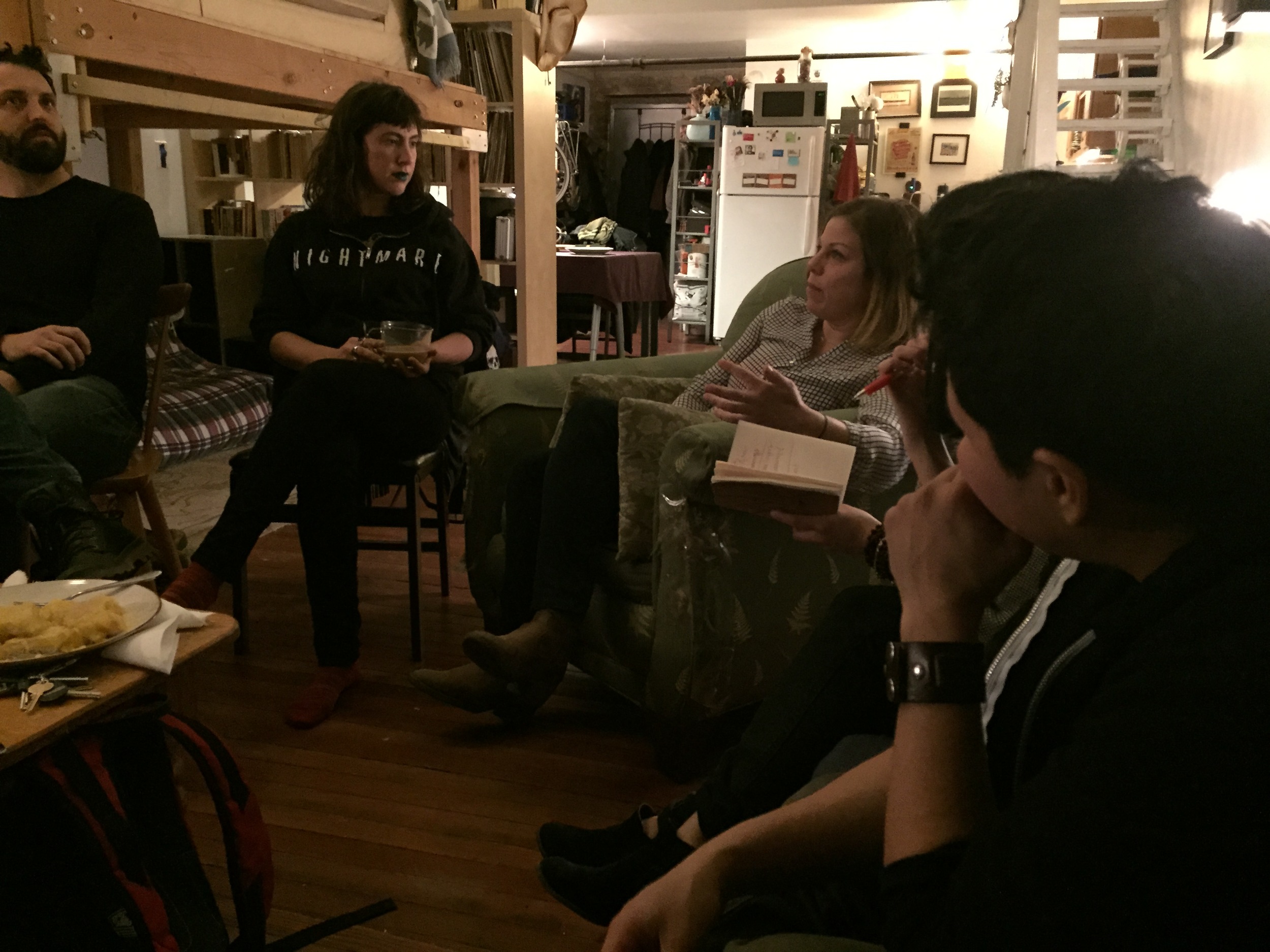
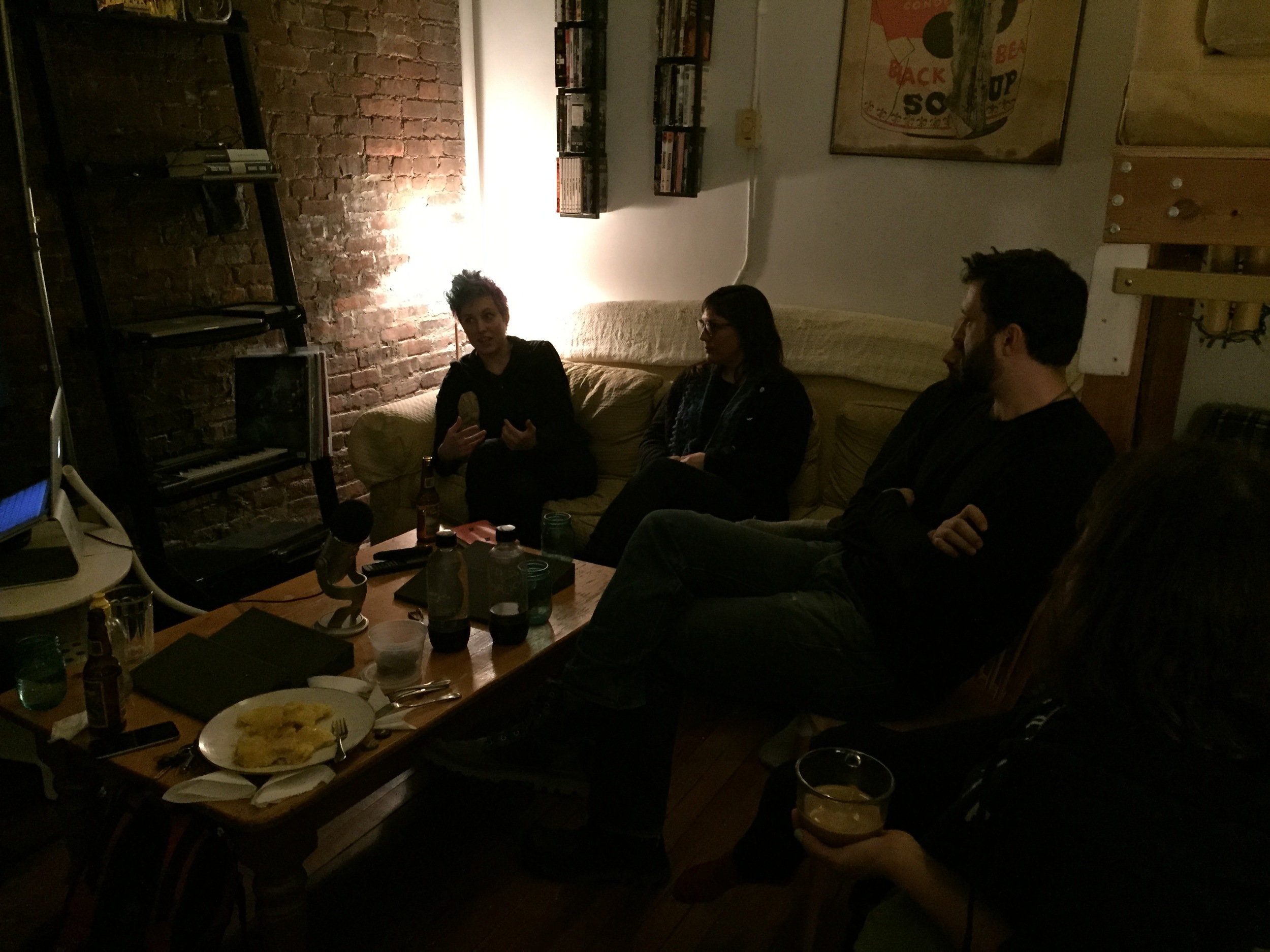
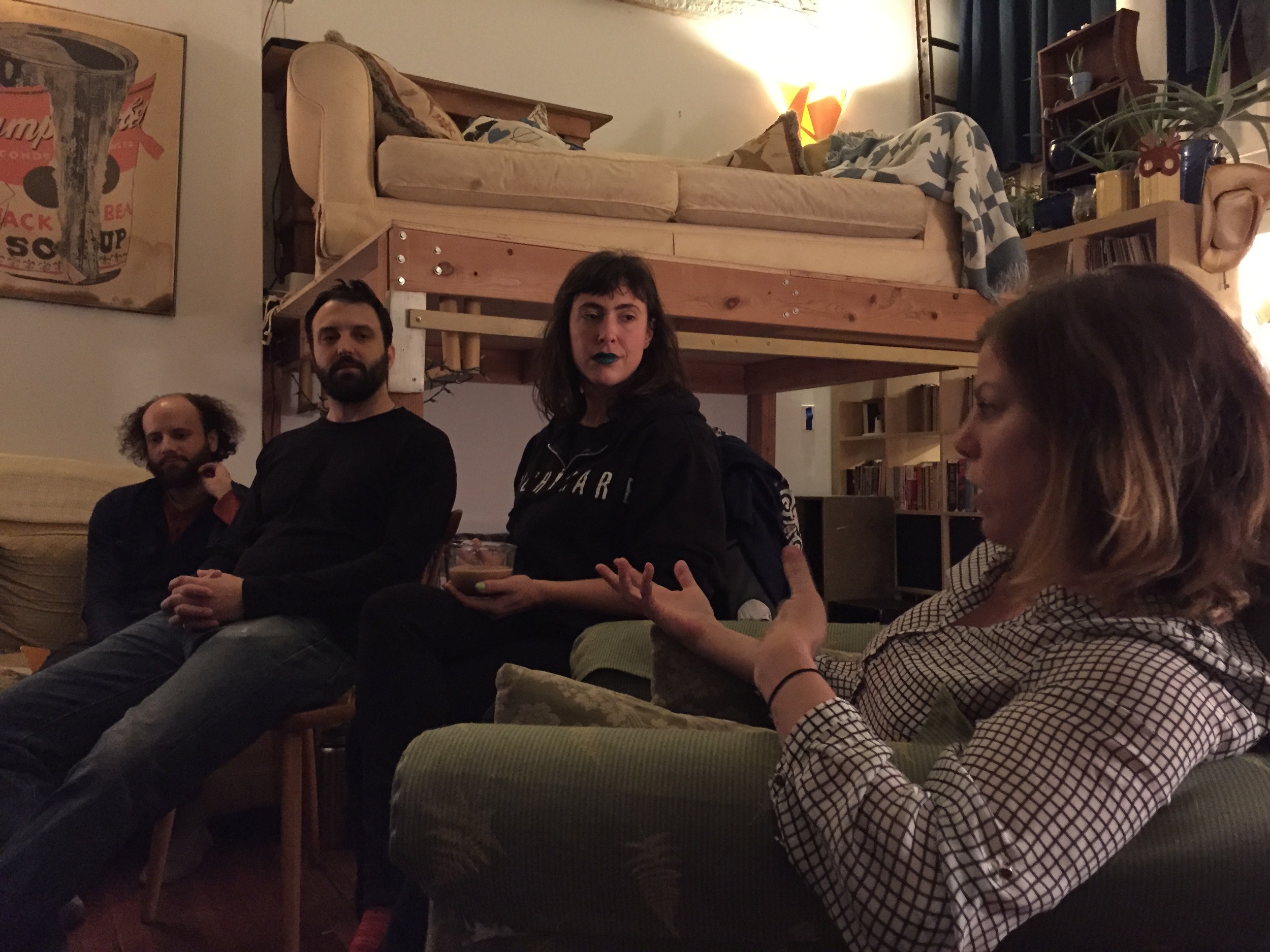

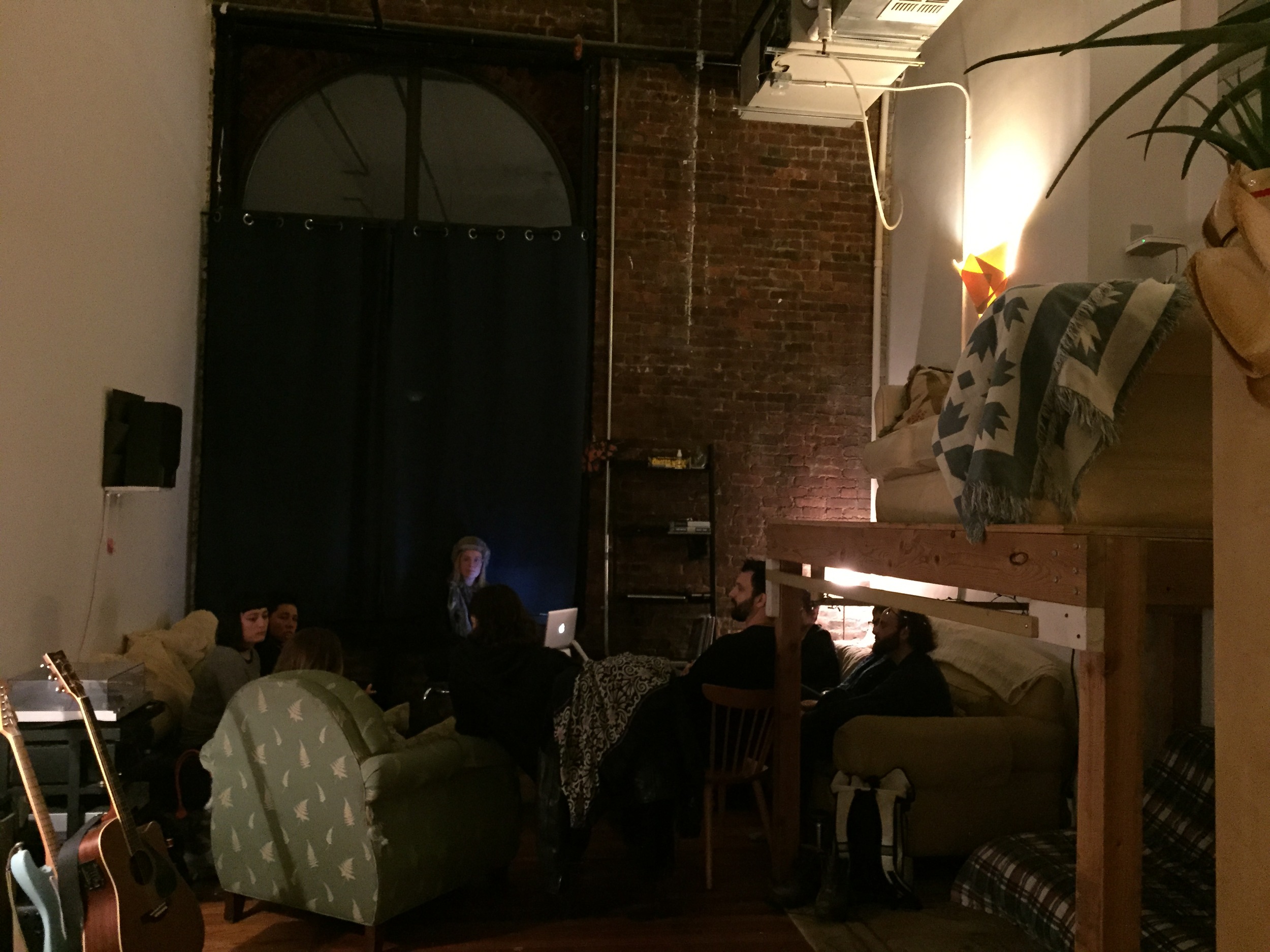
DISCUSSION 4
February 3, 2015
Location: Los Hermanos
Host: Marina Ross and Pia Coronel
Contributors:
Questions:
- What parameters do you put on your practice?
- Is meaning the same as voice?
Marina Ross and Pia Coronel co-moderate the discussion and start out by describing the relationships between intention, concept and meaning in order to diffuse the confusion between them and speak in more specificity. They began by asking what kinds of parameters each artist puts on their practice to establish continuity. G. Romero explained that his process always begins with an idea related to story-telling and that the materials that the process takes are irrelevant. Meg Franklin, on the other hand, begins with the material of paint and allows for discovery through that process. Maria Dimanshtein discusses how wide her parameters are by describing a piece she made that was in the snow and later existed in photographs only because of it’s impermanence. She said that it felt right to make it there even though the piece itself cannot be archival or displayed in a gallery. Pia asks about the relationship between ‘meaning’ and ‘style’ and if the two are the same. Sam Nigro explains how ‘style’ may be a branded term that is useful for a marketplace but not necessarily for an artist. Nikolina Kovalenko speaks about not always having an intention with her work in order for her audience to bring their point of view to it. Sam Nigro responds to this by saying that there is a responsibility that artists must have when making work and must be the authority of that work.
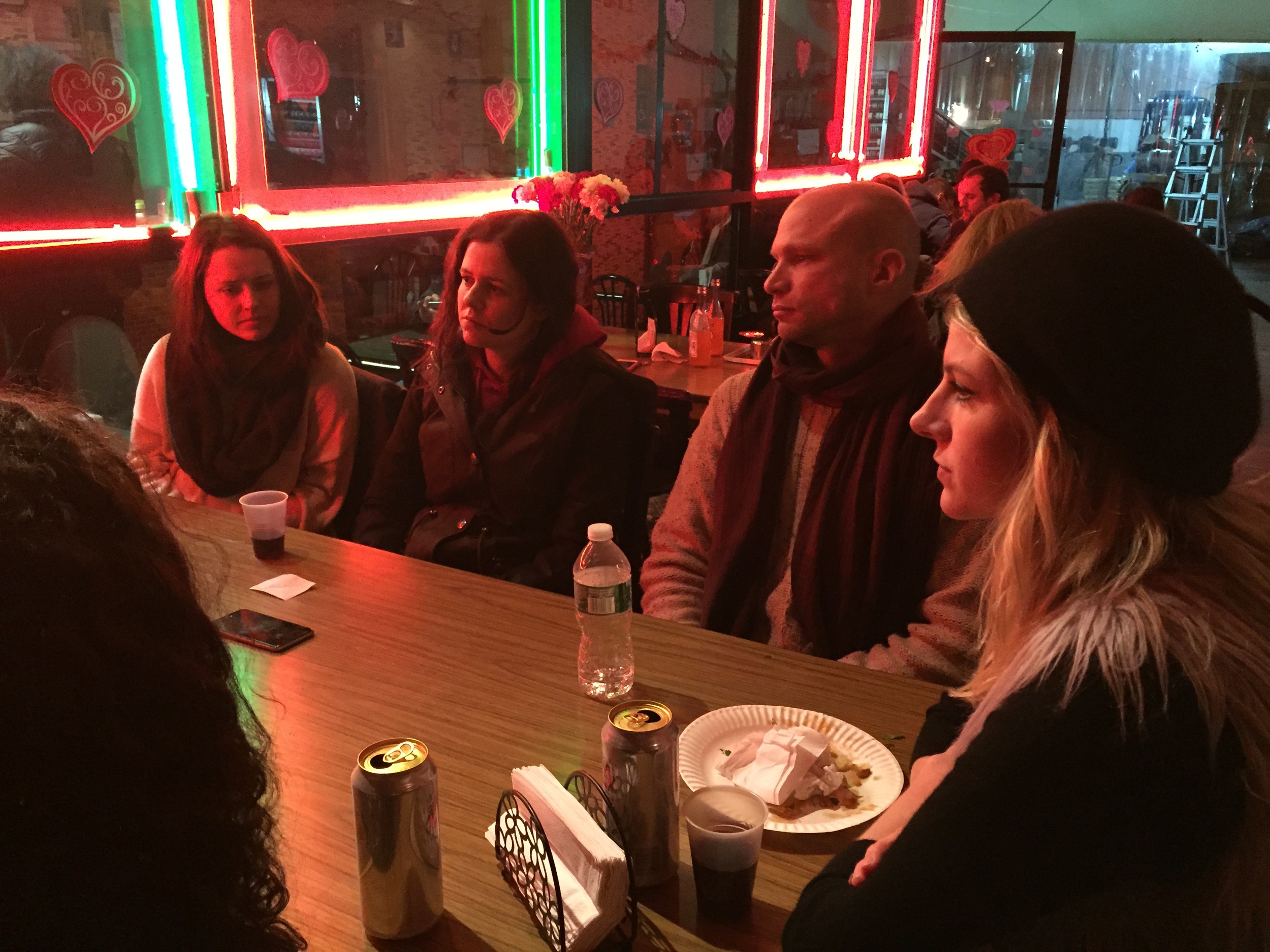
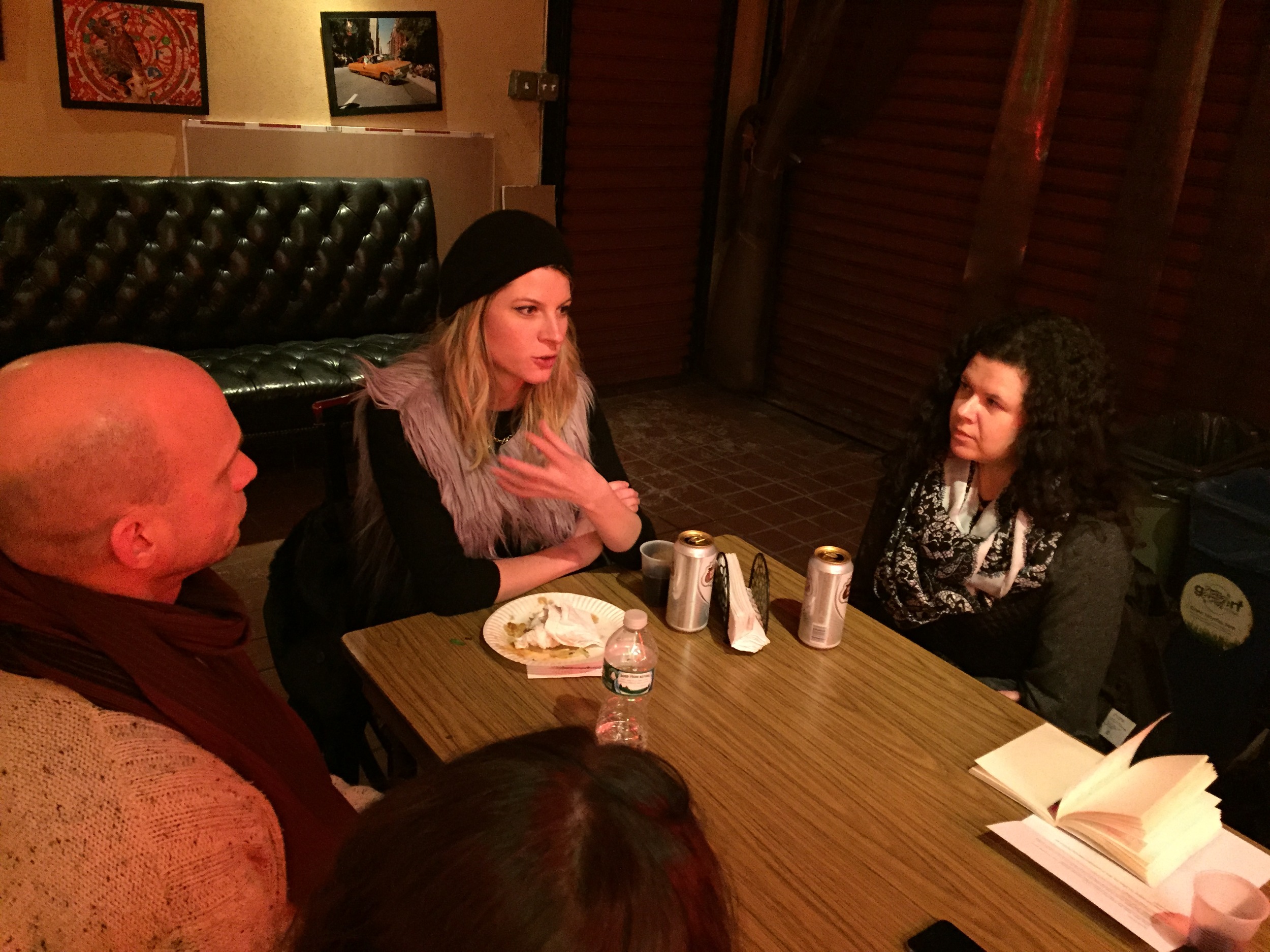

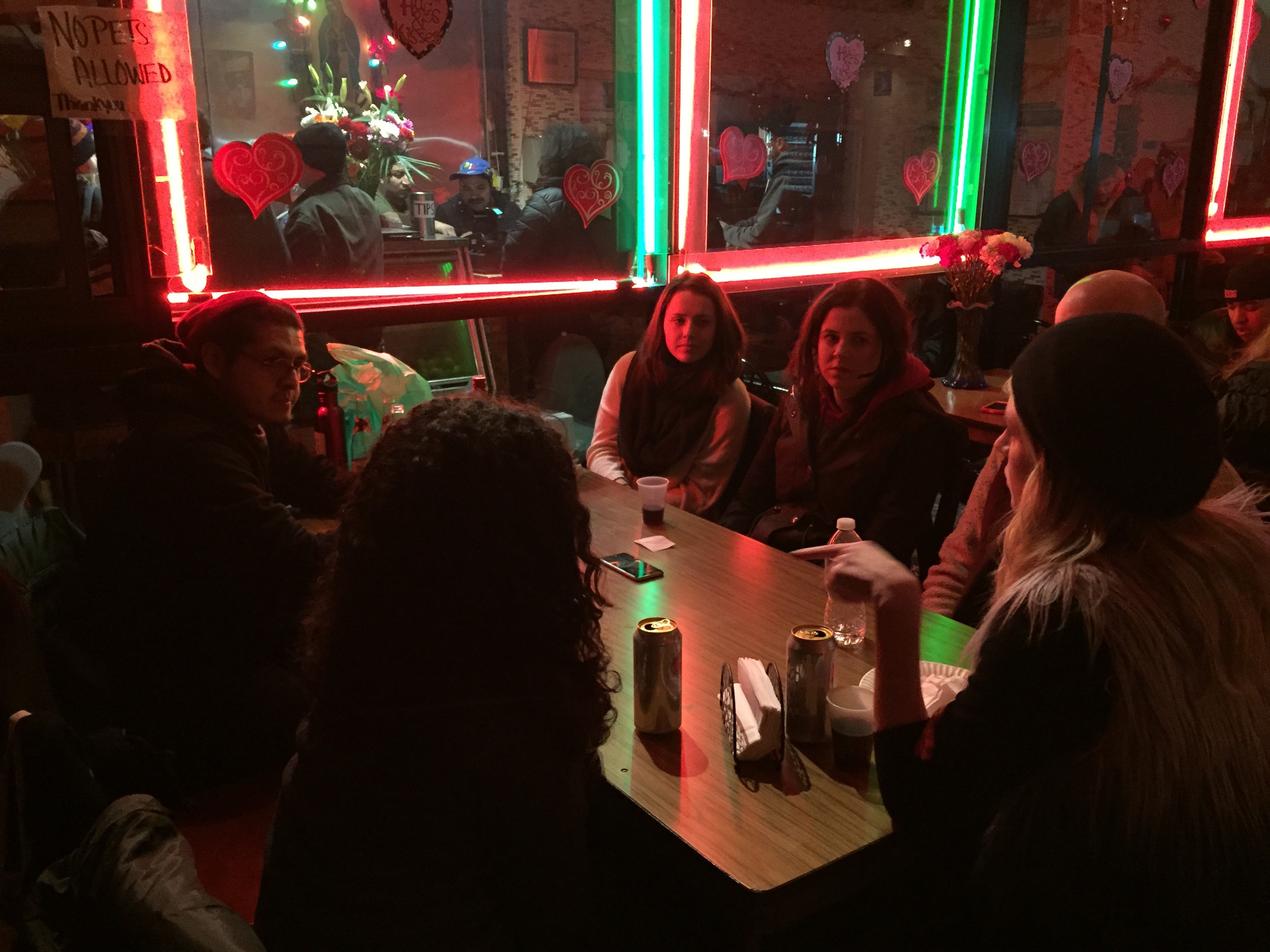
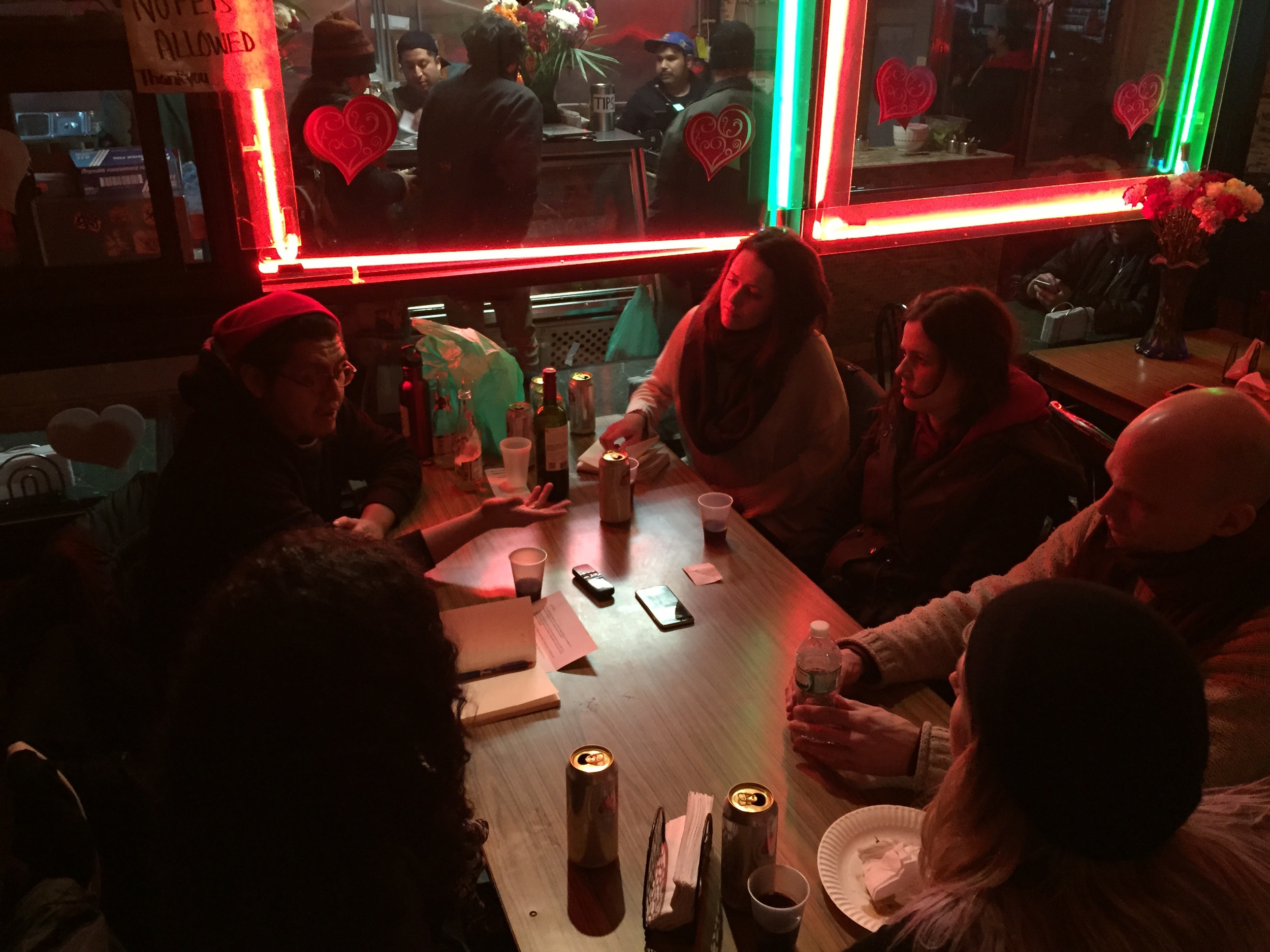
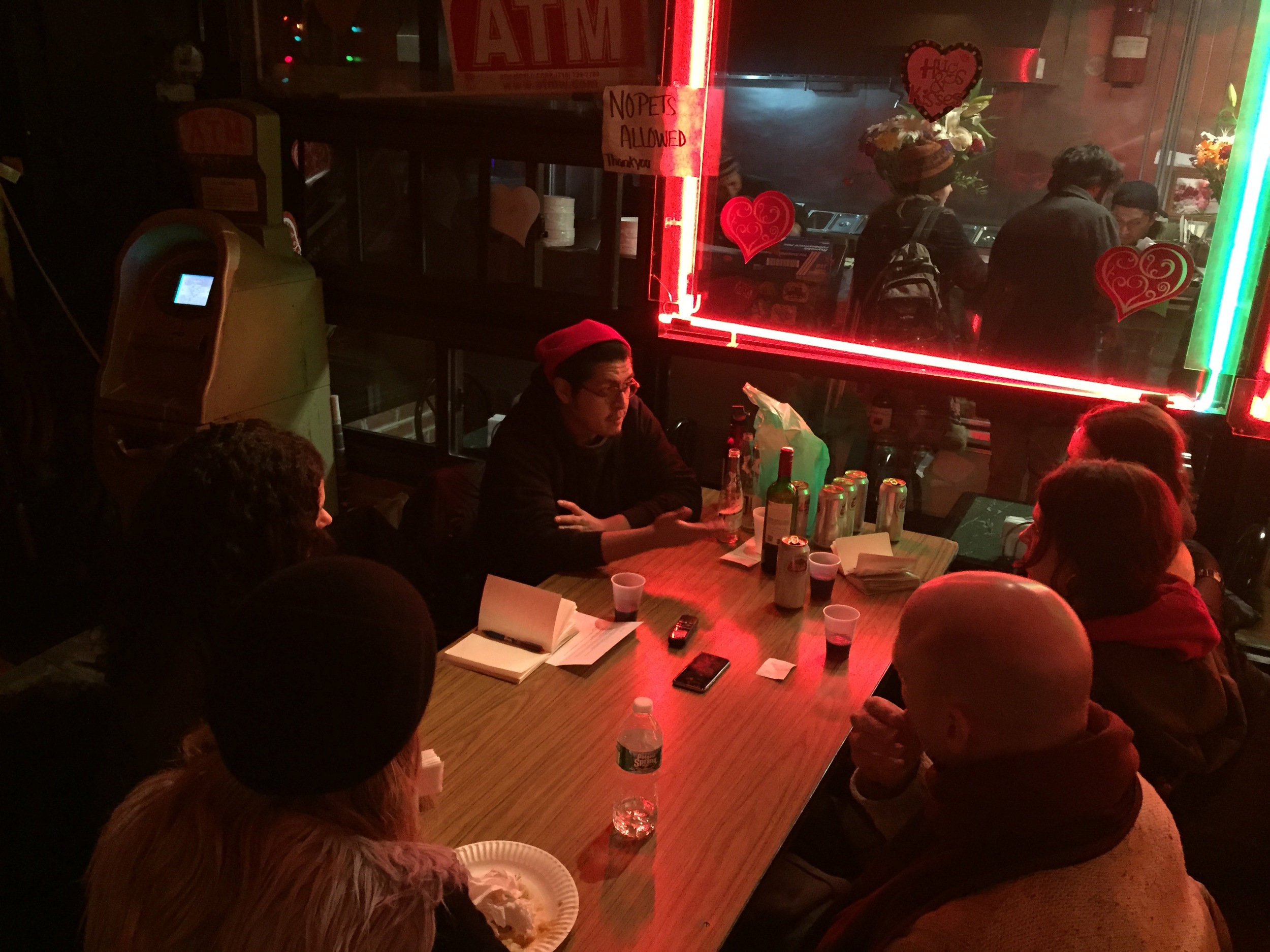
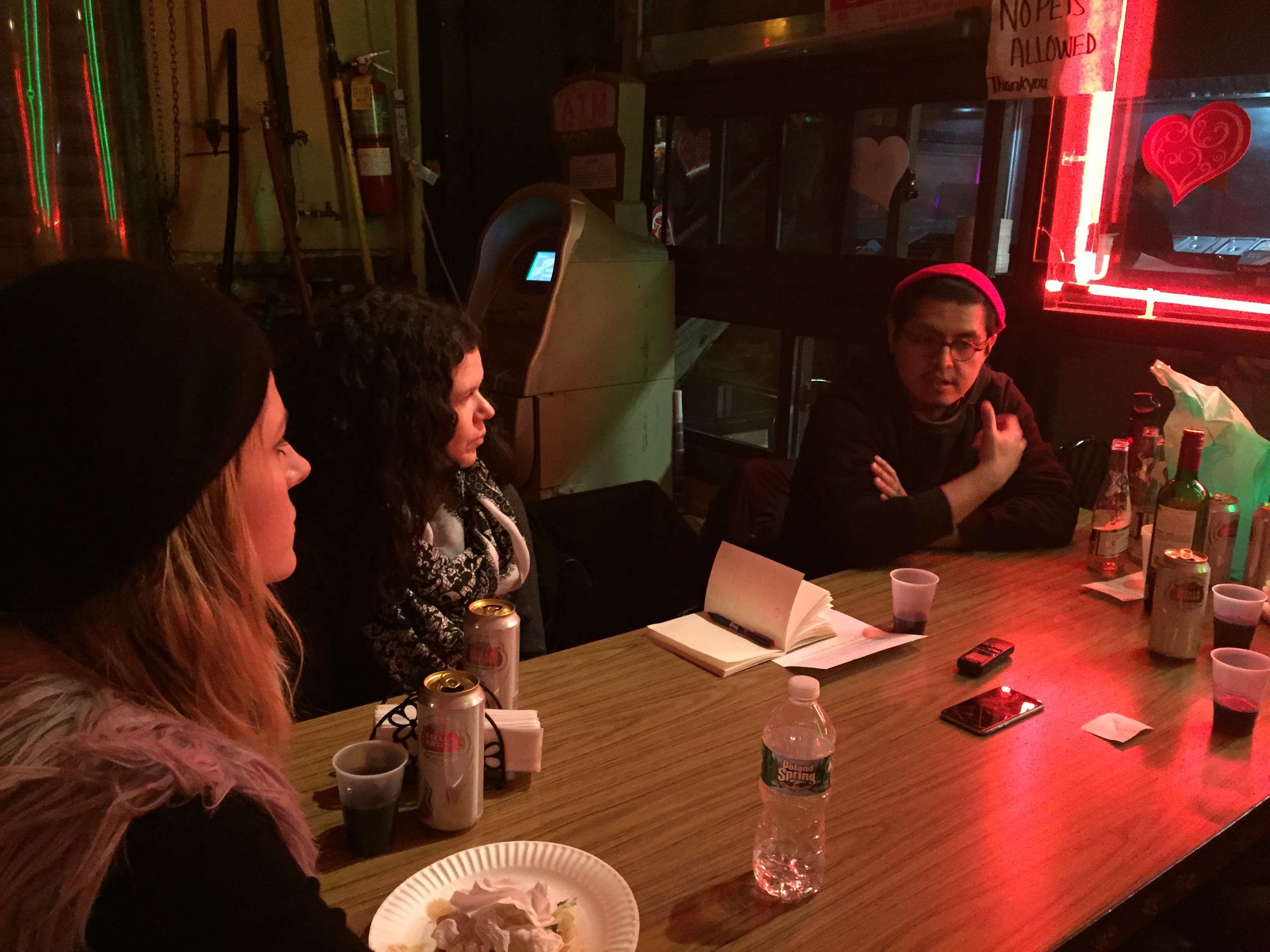
DISCUSSION 3
January 13, 2015
Location: Featherweight
Host: Michael Fleming
Contributors:
Questions:
- Do you start with an idea or with material?
- How do you know when a piece is done?
Michael Fleming begins our third discussion by asking whether our process begins with idea or with material. Raul Velverde talks about his varying process of research that precedes each work that he makes. Amie Cunat questions how that research takes shape because her own “research” is as simple as seeing something that she is drawn to. Any interest in a specific visual element is enough to constitute research. She goes on to say that her paintings echo the things that she is interested in rather than depict those things. When choosing a material to create a work, a certain set of ideas already comes that specific material. Jay Paavonpera uses a variety of everyday household items in hopes of helping a wider audience find a connection to his work. May Yueng describes how these household items are not as intimidating as painting may be. Many of the contributors in the talk have interdisciplinary and conceptual practices. The idea of logic comes up several times as a way to make sense of the kind of work they do. Because aesthetics are not important, a different type of logic needs to be established. This is influenced by history, an artist’s conviction and research. Toward the end of the discussion, we spoke about a video that Michael had sent beforehand to ground the conversation. We discussed the idea of deheroizing the artist’s practice and having a grand statement to say for a more daily art practice of going to the studio and working everyday.
Watch the video that Michael sent: Jan Verwoert:‘Why are conteptual artists painting again? Because they think it’s a good idea’
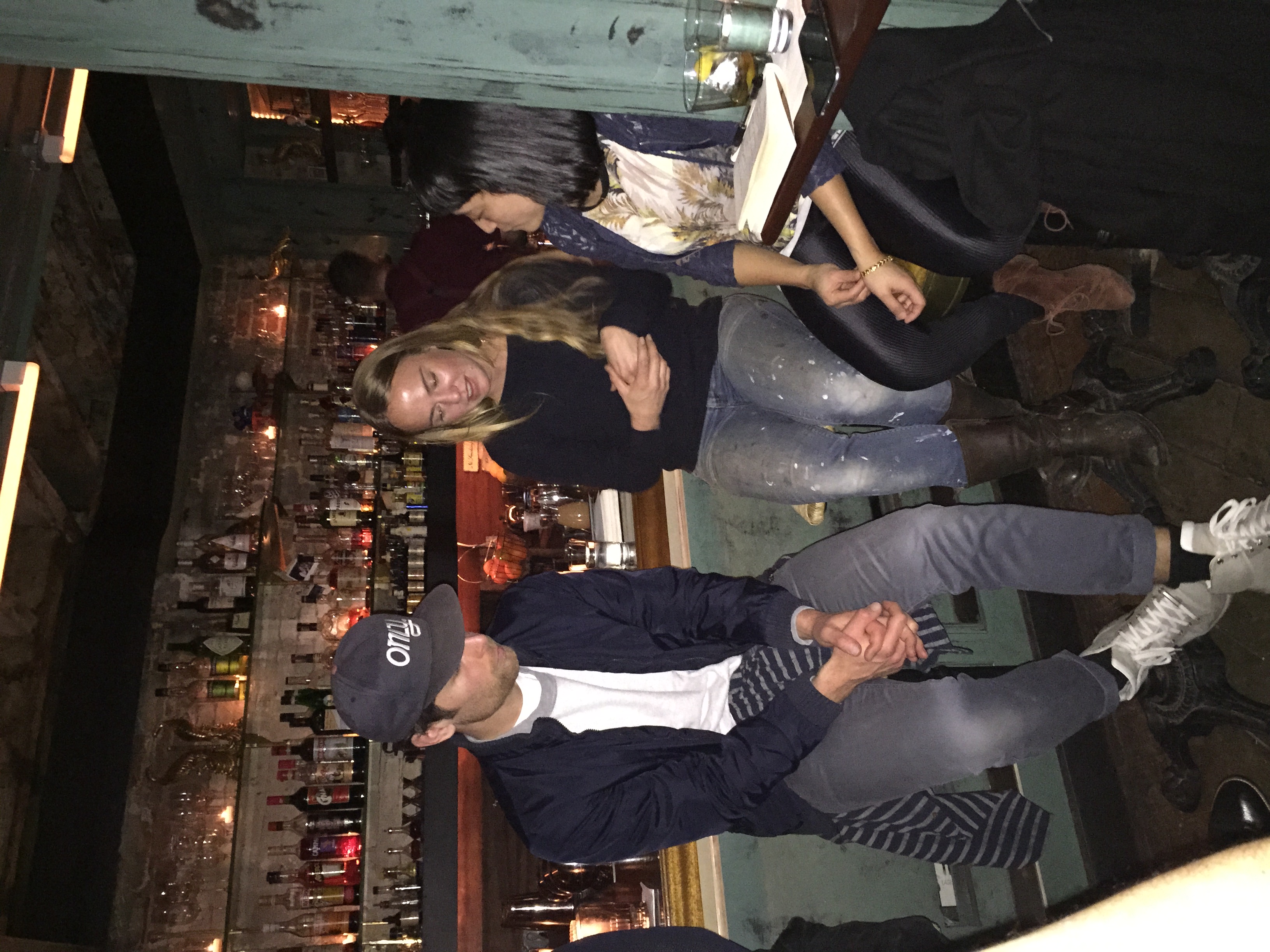
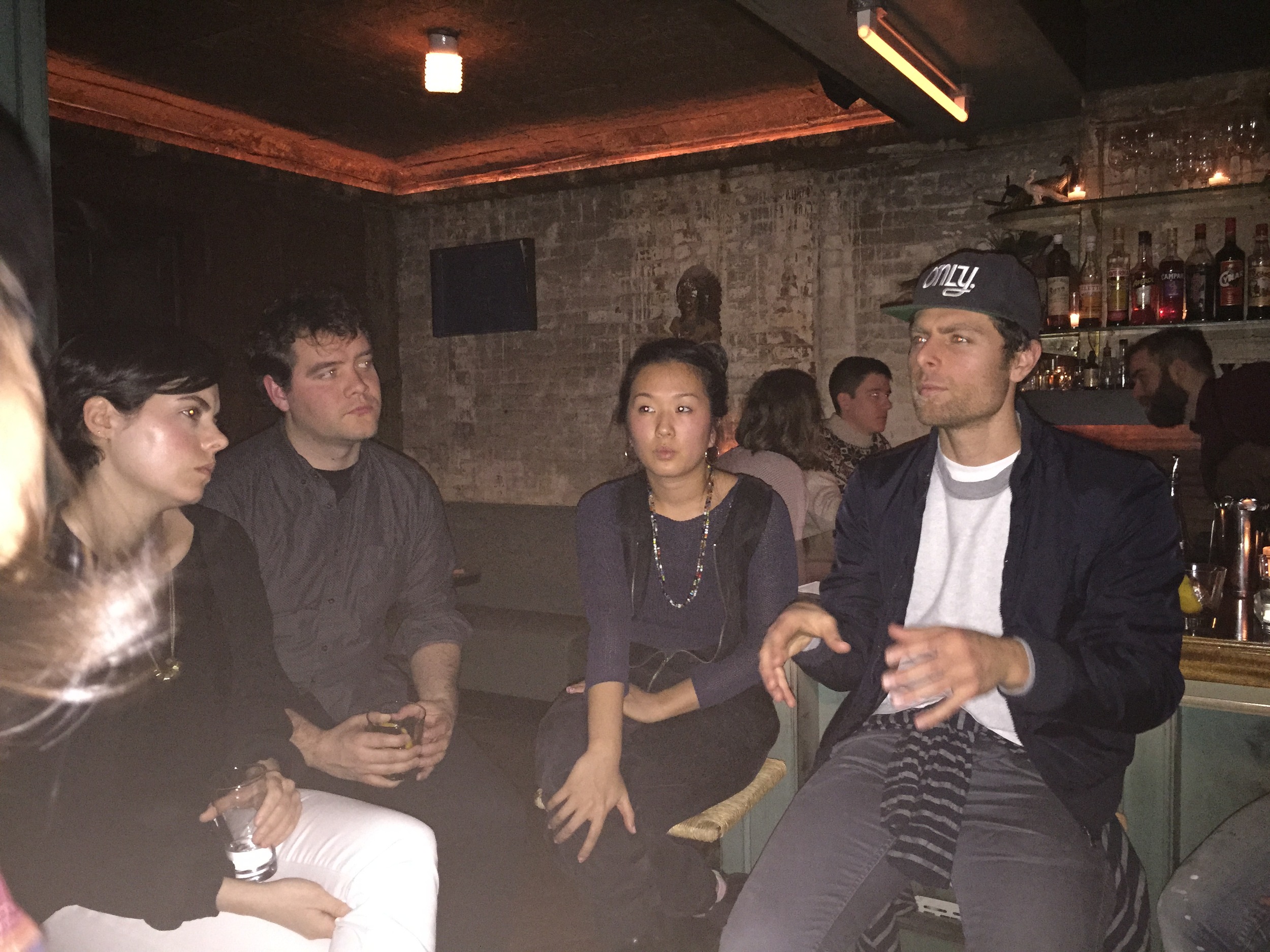
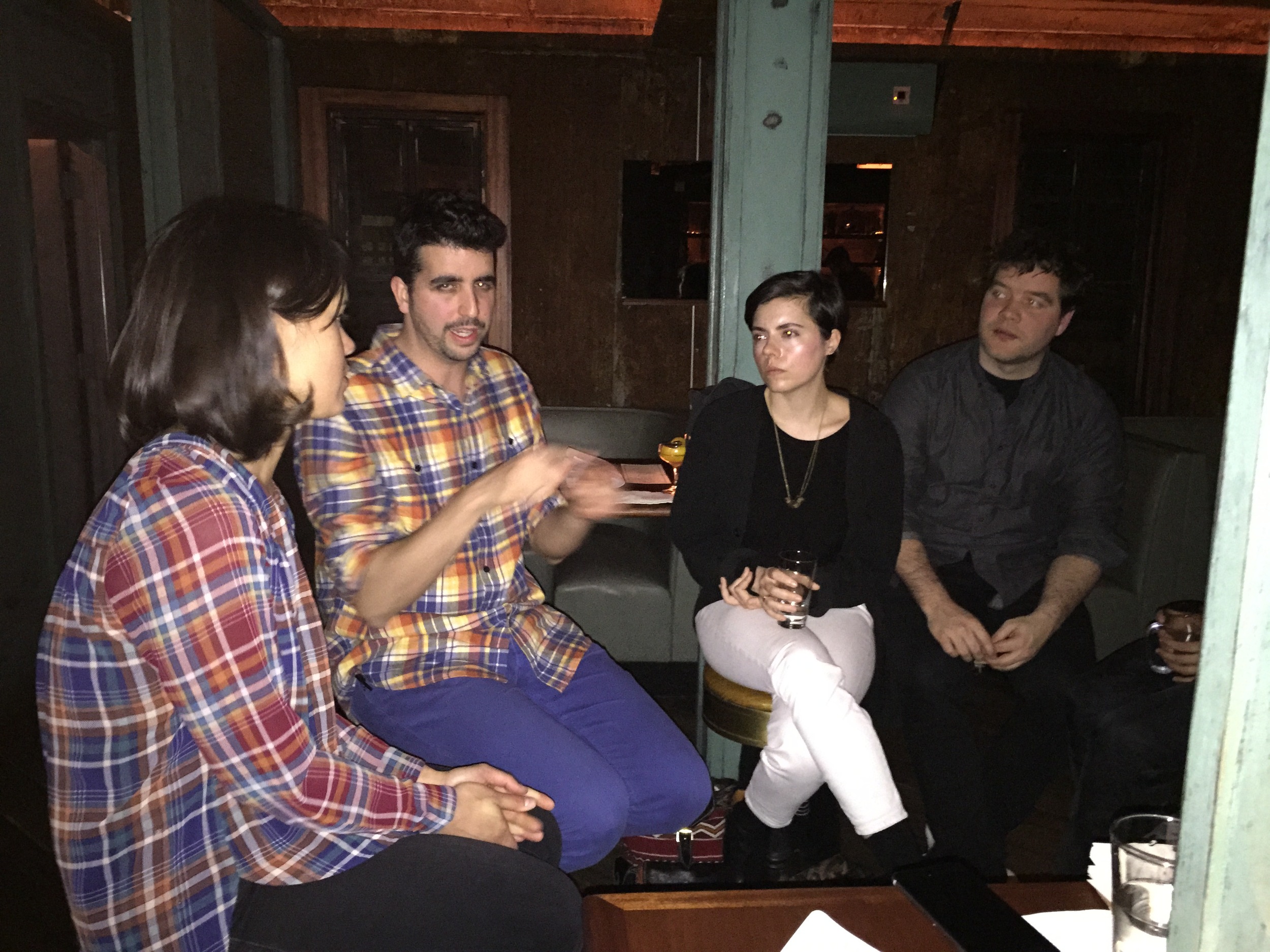
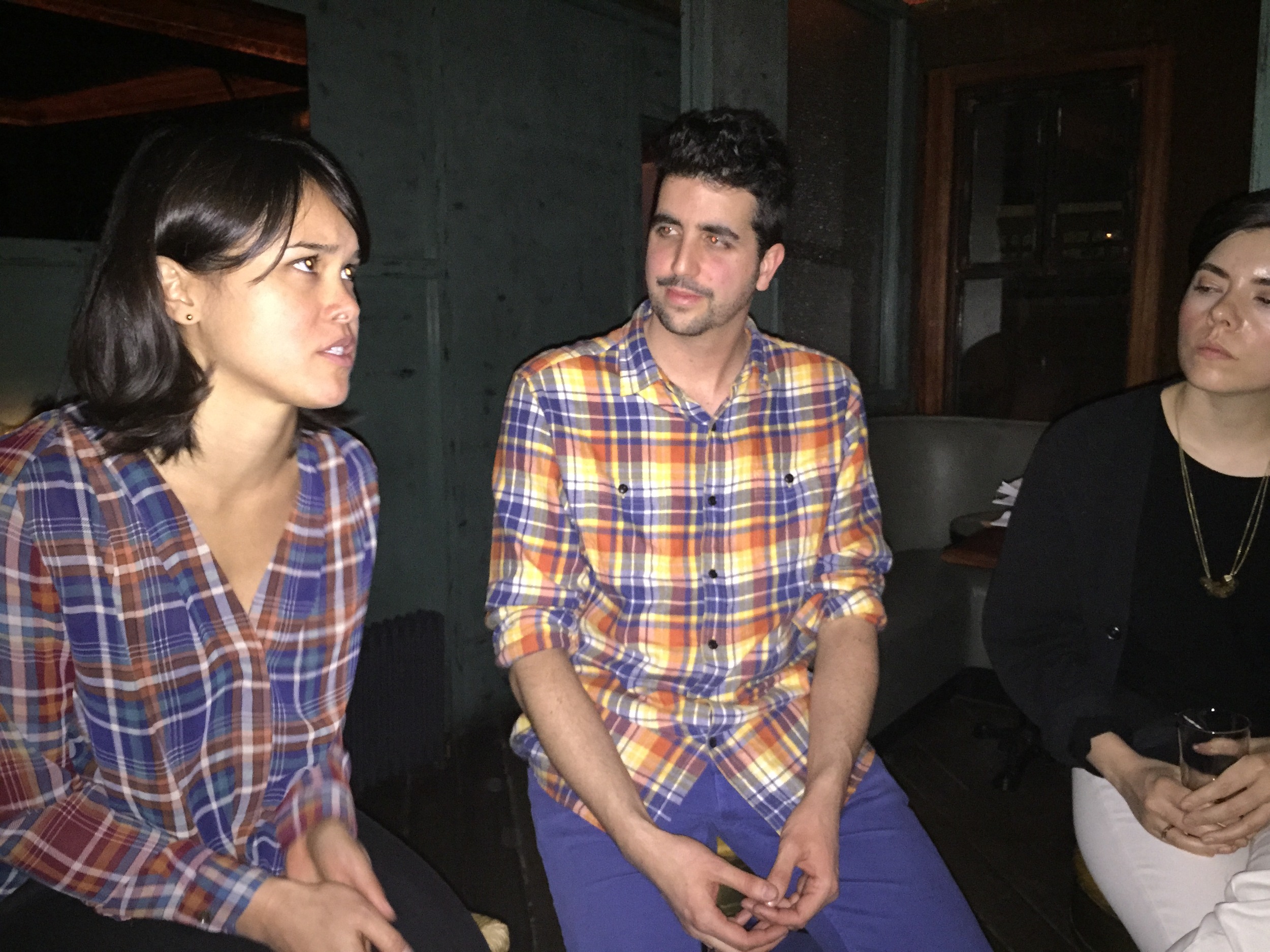
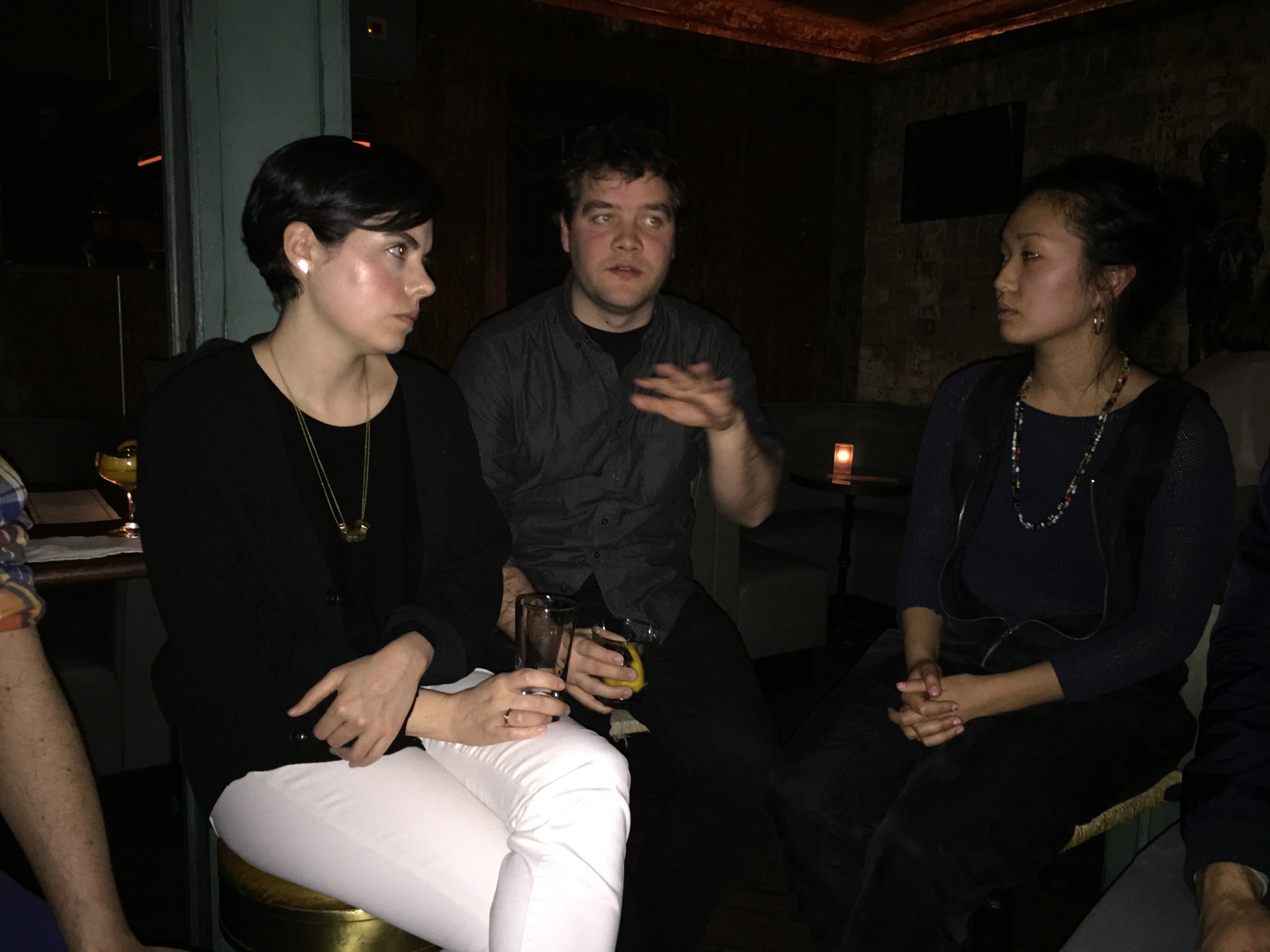
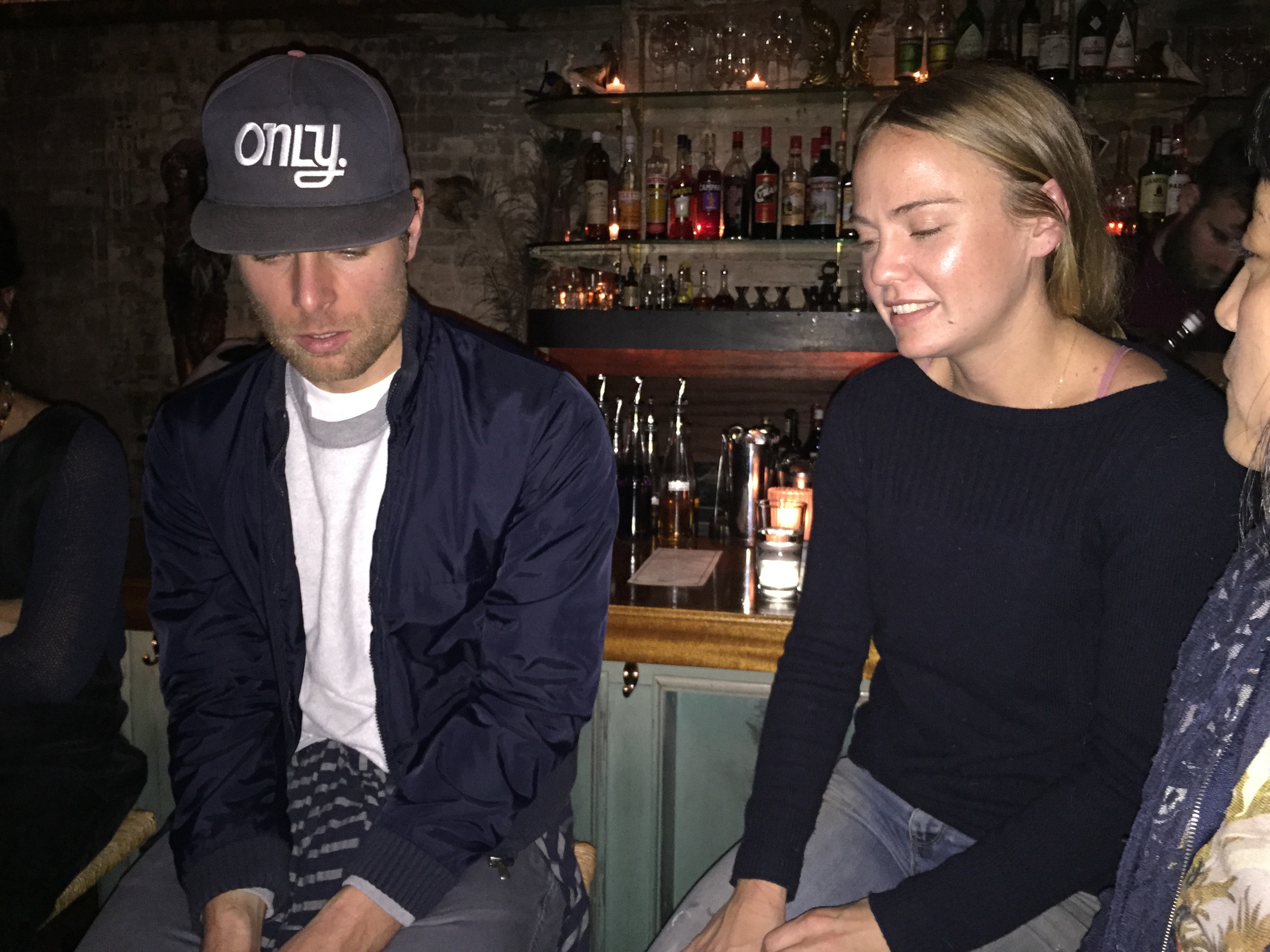
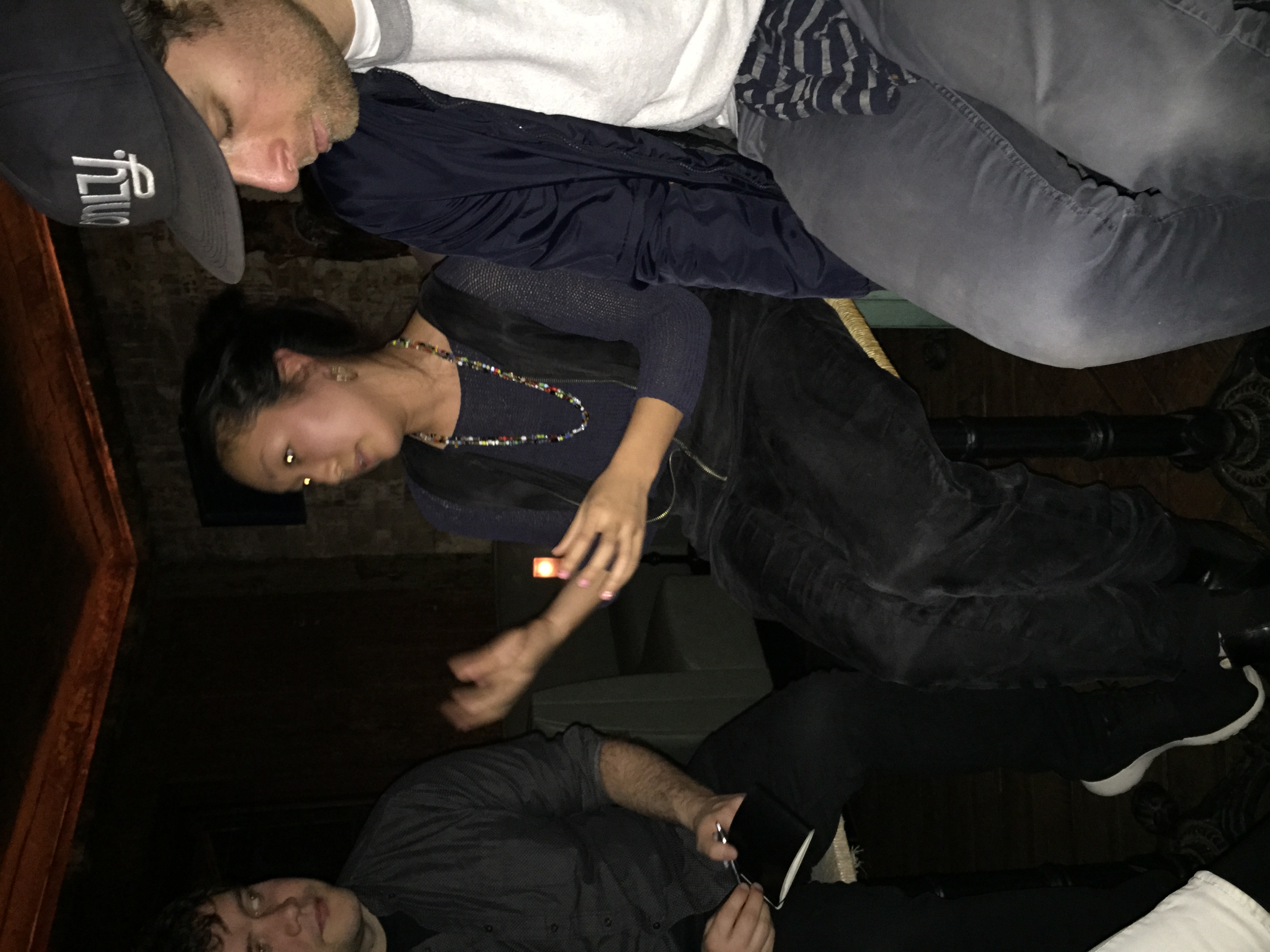
DISCUSSION 2
November 25, 2014
Location: Brooklyn Brush Studios
Host: Pia Coronel
Contributors:
Questions:
- Is there such a thing as creation without meaning?
- Is meaning the same as purpose?
- As a creator, how important is it for others to get the same meaning from the work ?
The conversation begins with Isa Freeling describing a story of her travels abroad, realizing the vast difference in cultural points of view. She explains how the experience made her question ideas of freedom and fairness and ultimately that meaning is created when your ideas are challenged. Jeff Koons makes his inevitable return back into our conversation as a symbol of extraordinary influence with seemingly little meaning. Nicole Brydson tells a story about an exhibition where she hears echos of "what is the meaning of this room?" throughout the space, contributing that the meaning was the search for meaning. We discuss how we are in search of and question meaning. The topic of Koons oftens receives a lot of upheaval because of his inflamed celebrity status while many do not empathize with his work. The conversation begins to focus on Kara Walker's recent sugar sphinx public installation at the Domino Sugar Factory in Brooklyn. Rain Embuscado emphasizes how many people were taking photographs with the sculpture and posting to social media. The visitors of the show did not realize that Walker was documenting them and would later create a work about that phenomenon. He states that there can be a gap between the work and the artist's intention. He says that the work and the artist statement could be two very different things. Raphael Zollinger describes Walker's work as a visual language that she adopts with a subject matter to really develop a concept. Through Koons and Walker's work, we talk about ideas of branding. Luis Martin suggests that the idea of branding evolved from the realization that history brands artists and now we are able to take that process into our own hands. We also cover post-internet work that exists only in the virtual realm and looks convincingly more interesting there than in real life.

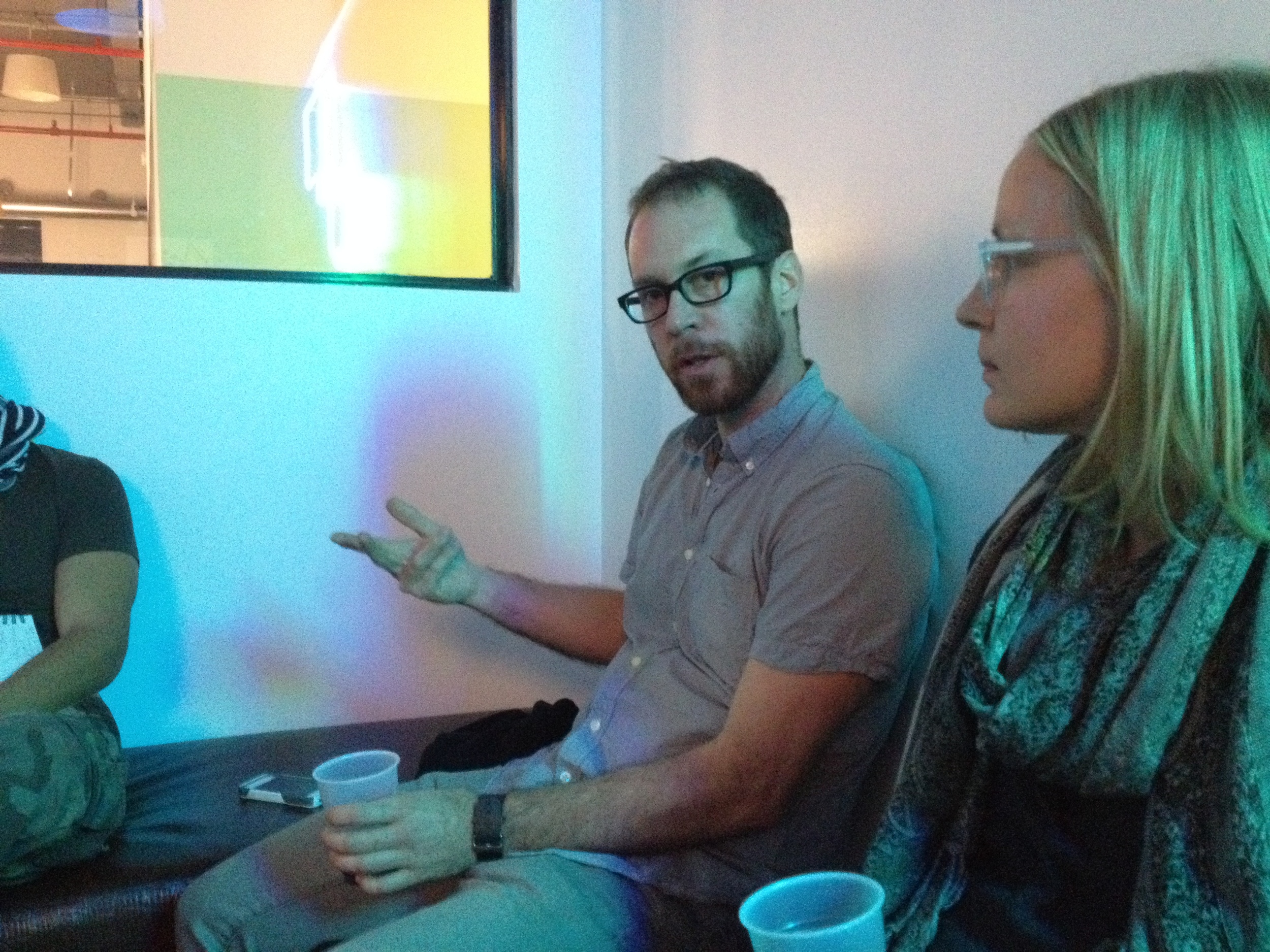

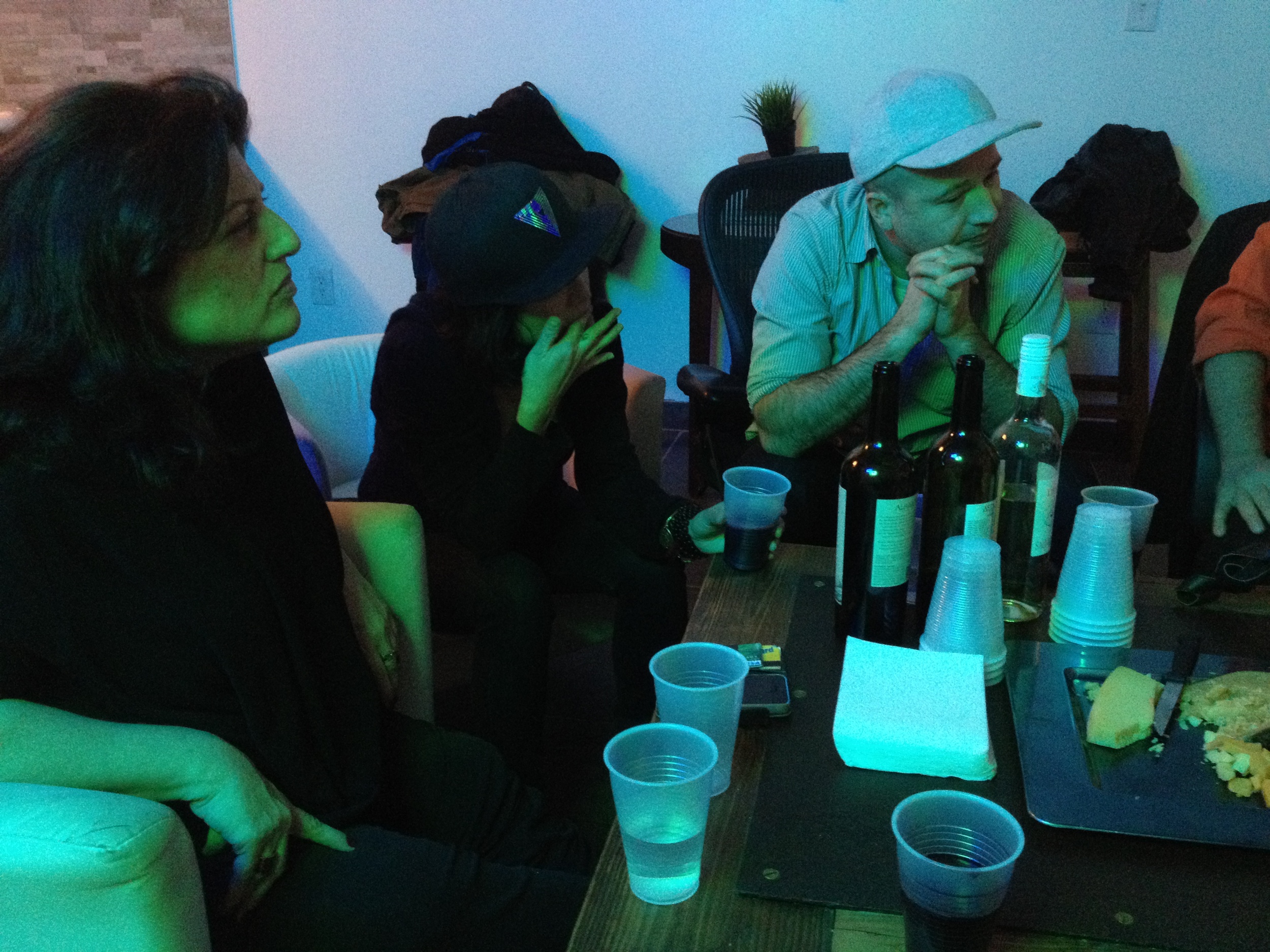
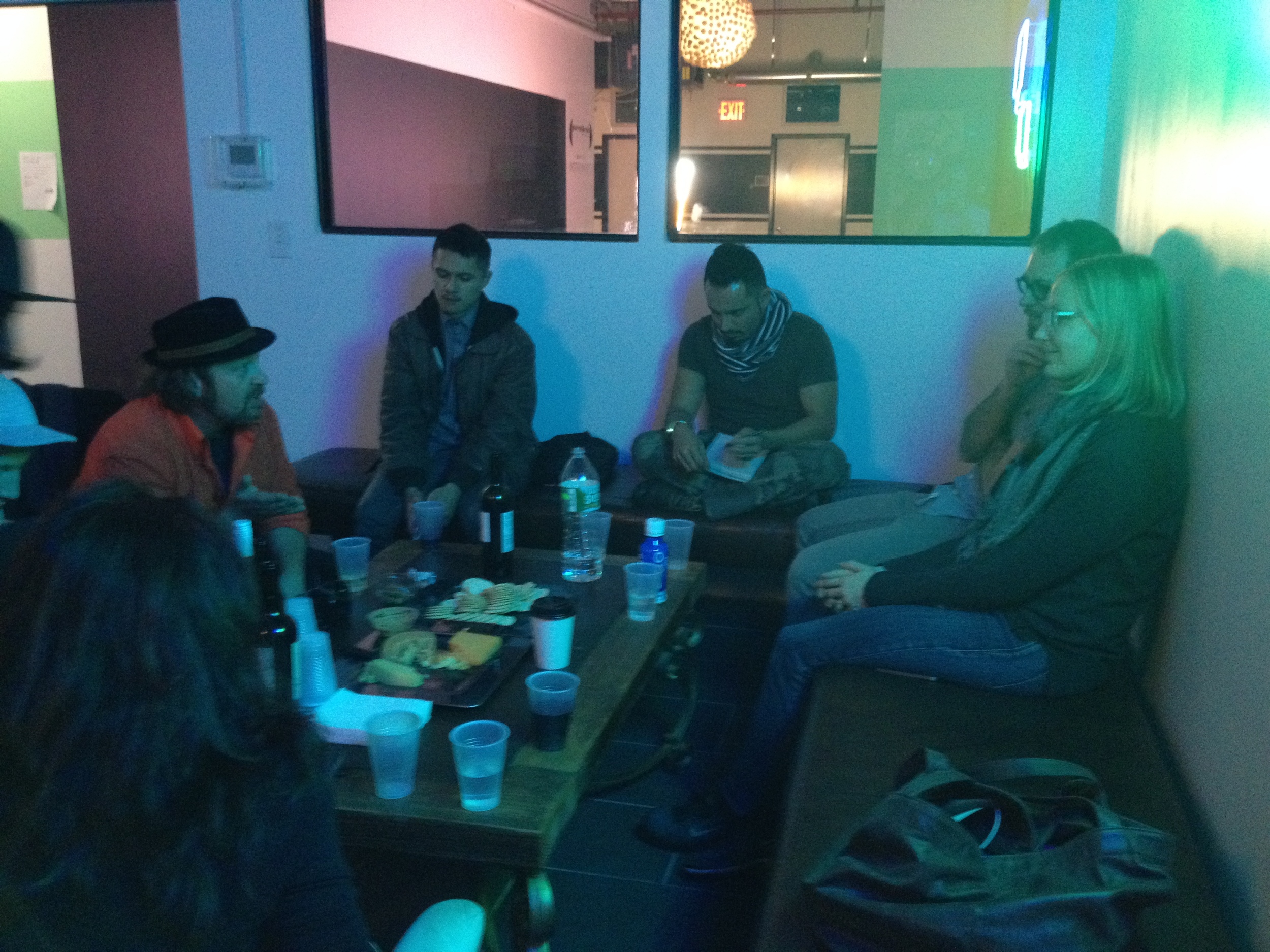
DISCUSSION 1
November 11, 2014
Location: Kave Espresso Bar
Host: Marina Ross
Contributors:
- Nico Brown
- Sessa Englund
- Michael Fleming
- Robert Hitzeman
- Francesca Marcaccio Hitzeman
- Emmaline Payette
- Paulapart
Questions:
- Is meaning important to art?
- Are certain meanings more suitable for art?
- What is art for art’s sake?
- Is meaning the same as communicating an idea?
- What devices do we use to point toward certain meanings in our work?
In the first session, Marina Ross poses questions regarding our feelings for meaning in art and how we develop meaning in our practices. Many of the artists in the group use the process of collaboration in their practice. We discuss the idea of meaning verses intention and function. Sessa Englund mentions that part of her concept is to obscure intention. ‘Art for art’s sake’ begins with an artist wanting to scratch an itch but may have larger implications when it deals with the idea of changing people’s perspectives. We deal with how an artist establishes a voice that can be heard across many types of materials. Nico Brown explains how an interest in watercolor or decorating his room always reveal his aesthetic. We find that meaning is subject to the read of an audience while communicating certain ideas may be more straight-forward. Michael Fleming states the in good work, something spiritual or about the artist’s intention will translate to an audience while in bad work, it will not. This isn’t always a direct translation but a certain amount of energy is able to be travel from the artist to the audience.




